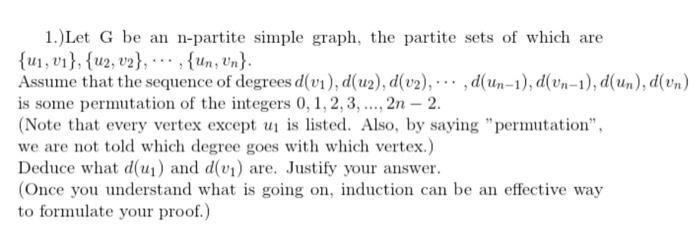Question
1.) Let G be an n-partite simple graph, the partite sets of which are {ui, vi}, {u2, v2}, {un, Un}. Assume that the sequence

1.) Let G be an n-partite simple graph, the partite sets of which are {ui, vi}, {u2, v2}, {un, Un}. Assume that the sequence of degrees d(v), d(u2), d(v2),..., d(un-1), d(vn-1), d(un), d(vn) is some permutation of the integers 0, 1, 2, 3,..., 2n - 2. (Note that every vertex except u is listed. Also, by saying "permutation", we are not told which degree goes with which vertex.) Deduce what d(u) and d(v) are. Justify your answer. (Once you understand what is going on, induction can be an effective way to formulate your proof.)
Step by Step Solution
3.52 Rating (162 Votes )
There are 3 Steps involved in it
Step: 1
To deduce the degrees of vertices u1 and v1 in the npartite simple graph G we can use induction and some observations about the degrees of the vertice...
Get Instant Access to Expert-Tailored Solutions
See step-by-step solutions with expert insights and AI powered tools for academic success
Step: 2

Step: 3

Ace Your Homework with AI
Get the answers you need in no time with our AI-driven, step-by-step assistance
Get StartedRecommended Textbook for
Discrete and Combinatorial Mathematics An Applied Introduction
Authors: Ralph P. Grimaldi
5th edition
201726343, 978-0201726343
Students also viewed these Mathematics questions
Question
Answered: 1 week ago
Question
Answered: 1 week ago
Question
Answered: 1 week ago
Question
Answered: 1 week ago
Question
Answered: 1 week ago
Question
Answered: 1 week ago
Question
Answered: 1 week ago
Question
Answered: 1 week ago
Question
Answered: 1 week ago
Question
Answered: 1 week ago
Question
Answered: 1 week ago
Question
Answered: 1 week ago
Question
Answered: 1 week ago
Question
Answered: 1 week ago
Question
Answered: 1 week ago
Question
Answered: 1 week ago
Question
Answered: 1 week ago
Question
Answered: 1 week ago
Question
Answered: 1 week ago
Question
Answered: 1 week ago
Question
Answered: 1 week ago
View Answer in SolutionInn App



